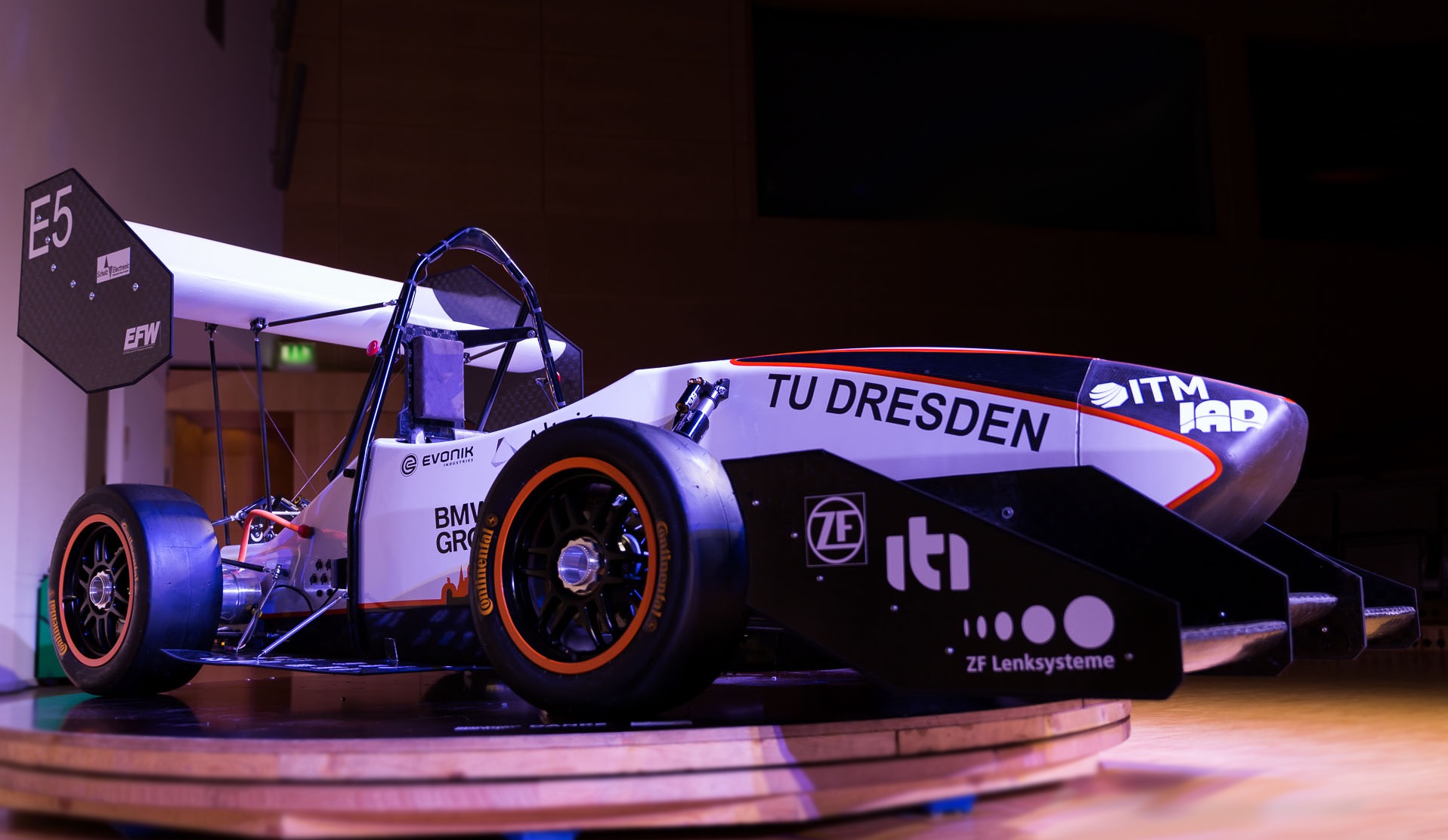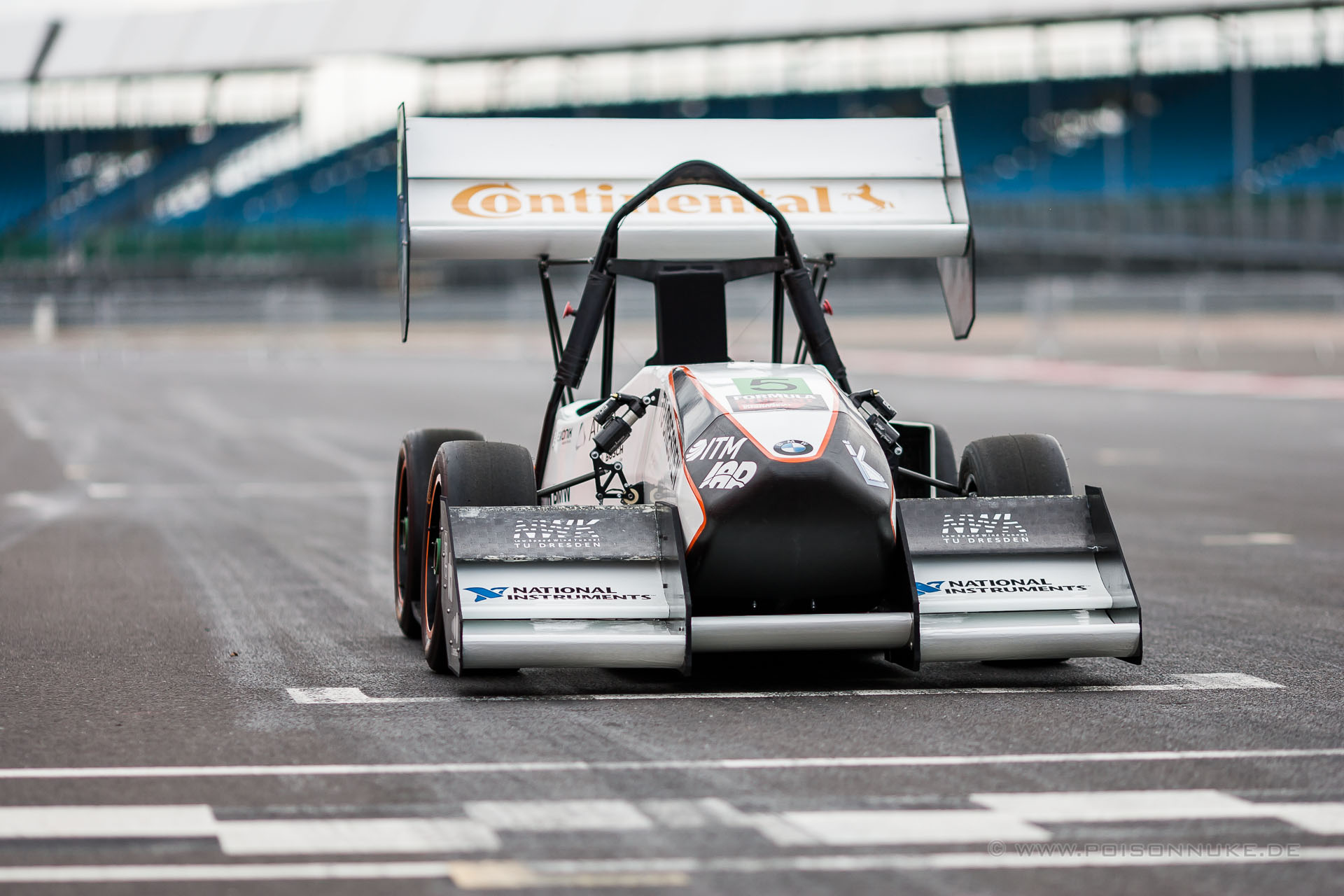JulE


Key Facts
| Weight: | 197 kg |
| Engine Power: | 2 x 24 kW |
| Torque at the rear axle: | 720 Nm |
| Voltage | 600 V |
| Acceleration (0-100 km/h): | 3.0 sec |
| Maximum Velocity: | 120 km/h |
Frame and Body
In this year’s car, the aerodynamic concepts of the sub team have excelled. For the first time, we have a complete wing package with underbody. Our sixth monocoque, constructed this year from prepreg CFRP and cured in an autoclave, also fits into the aerodynamic concept, with a flat bottom and inverted wing shape. This year we’ve paid great attention to very high stiffness in the monocoque – mainly through geometric methods, but also through improved layer structure.
A brief overview about our improvements:
Aerodynamics
- Testing of old cars in the wind tunnel for validation of the design specifications
- Use of a three part wing profile for front and rear
- Use of an underbody
- Adjustment of the monocoque form according to aerodynamic requirements
Weight reduction
- Layer optimisation through iterative testing as well as FEM calculations
- Geometric improvements to increase stiffness with fewer layers
Ergonomics
- Lower-lying driver position and therefore lower centre of mass
- Seat with more lateral support
- Simplified headrest design
- Lower seatbelt attachment to secure the driver better vertically
Maintainability
- Maintenance hatch in electronics area
- Rail system for battery and inverter for easy removal and installation
- Easy access to the pedals
Safety
- Cover of internal suspension components with FRP parts
- Preservation of the fire resistant LEO-System for the firewall
- Design of the shoulder harness bar with high regard for safety
Suspension
Due to the new drive concept and the aerodynamics package, the suspension from last year was completely reworked for JulE. With the help of improved hub kinematics and an adjusted damper position, the transfer of forces to the monocoque could be reduced as far as possible to a minimum. The wishbone kinematics of KatE’s season produced excellent results, which is why only small changes were applied to this area of the car. So that the potential of the tyres could be better utilised, the steering kinematics were further developed. Furthermore, due to the new steering, the steering forces were minimised and consequently the handling improved. In order to be able to withstand the increased downforce induced by the aero package, we decided to use an air-spring-damper system, due to the progressive spring characteristics and also the fact that they are lower in mass than the equivalent conventional spring-damper system. In spite of the increased downforce, the weight of the wishbones was able to be decreased through further development of our injector-adhesive technology. On the rear axle the uprights were completely redesigned to incorporate the gear hub drive. Further technical characteristics:
Tyres and Rims
- Continental 205/510 R13
- Magnesium lightweight central locking rims 7 x 13
Spring/damper unit
- Air-spring-damper system with more setting options in high and low speed ranges for jounce and rebound
- Sword type anti roll bars on both front and rear axles
Brake system
- AP racing calipers – 4 pistons at the front, 2 at the rear
- Self-developed steel discs
- Balance bar system for brake force distribution adjustment
Steering
- Weight optimised steering gear with in-built steering angle sensor
- Right angled steering linkage between the steering wheel and gear transferred via a 90° angular gear
Wishbones
- CFRP tubes with aluminium inserts
- Injector adhesive technology for increased reliability
Uprights
- Topology optimised 5-axis mill construction from high strength aluminium
- Camber adjustment by camber plates
- Integrated motor and gearbox mounting on the rear axle
Electronics
The module Electronics deals with all LV components in the vehicle.
This includes all the boards belonging to the control and regulation but also to secure the vehicle.
Furthermore, the LV harness got designed by us, the software, the sensors for monitoring the vehicle systems and the safety circuit, which is used in case of failure of an emergency shutdown of the entire vehicle.
Also, the housings for the electronic components were made by us.
All of these components we put on our car were a further development of our car from last year Kate.
We have a smaller and faster sb RIO from National Instruments, which is the brain of the vehicle. The number of sensors was extended and even a real-time data and video transmission while driving is now possible.
Sensors
- Wheelspeedsensor
- Brake pressure Sensor
- Brake disc temperature sensor
- Tyre temperature sensor
- Coolant temperature sensor
- Suspension Travel Sensor
- 6-Axis-Sensor
- Steering Angle Sensor
- Currentsensor
- SmartSensor-Principle to convert the sensor data onto CAN-Bus
Telemetry
- the latest single board RIO by National Instruments
- WLAN Network für Data transmission on the Test Track
- Live-Telemetry
Controls
- software programmed in LabVIEW
- 2 CAN Busses for data transmission ang drive control
- Torque Vectoring, electric Differential, Antislipregulation
- Recuperation
Housings
- CFRP Housings for the electrics
- elektromagnetic shielding with coppermash
- EMI Test to confirm shielding technology
Shutdown System
- Inertia Switch
- Insulation Monitoring Device
- Brake over Travel Switch
- Shut Down Buttons
Cable Harness
- modular vehicle power
- Motorsport connectors
E-Drivetrain
The Accumulator represents a further development of last year’s technology. The cell connection was optimized for the ease of the maintenance – so we are able to change single cell connections shortly. The hardware and software of our battery management system was adapted to our new battery and still guarantees us a complete monitoring of the sensitive LiPo-battery cells.
Our whole propulsion system was construed new and due to the analysis of our log-data is now much smaller and lighter. This year the inverter housing embraces additionally the HVD and the electrical connection of the Accumulator. In JulE, the rail system for the battery was extended to the connection of the inverter housing.
JulE is our first car with a wheel-hub drive. Because of the low designed space and the high engine speed, we built a two-stage gear. In the rear uprights is a spur gear with an upstream planetary gear.
This year´s cooling system has as a centerpiece a self developed cooling which perfectly suits our requirements. The Inverters are integrated into the cooling circle with a self constructed cooling plate. We rely on a common cooling circle for motors and Inverter.
Accumulator
- Maximum voltage: 600 V DC
- Energy: 7 kWh
- 288 Lithium-Polymer-cells, 144s2p
- Voltage: 3,7 V
- Capacity: 6,7 Ah
- Max. discharge current: 220 A
- Self-developed battery managemant system
- DC/DC-converter to supply the 24V net
Propulsion system
- Two brushless synchronous motors Siemens 1FE1051
- Max. power: 24kW per motor
- Max. torque: 11Nm per motor
- Max. speed: 40 000 rpm
- Two inverters Siemens SINAMICS S120
- Max. output current: 56 Aeff
- Max. output voltage: 430 VACeff
Gearbox
- Two-stage gearbox integrated in the rear uprights
- Spur gear with an upstream planetary gear
- Gear ratio: 33:1
